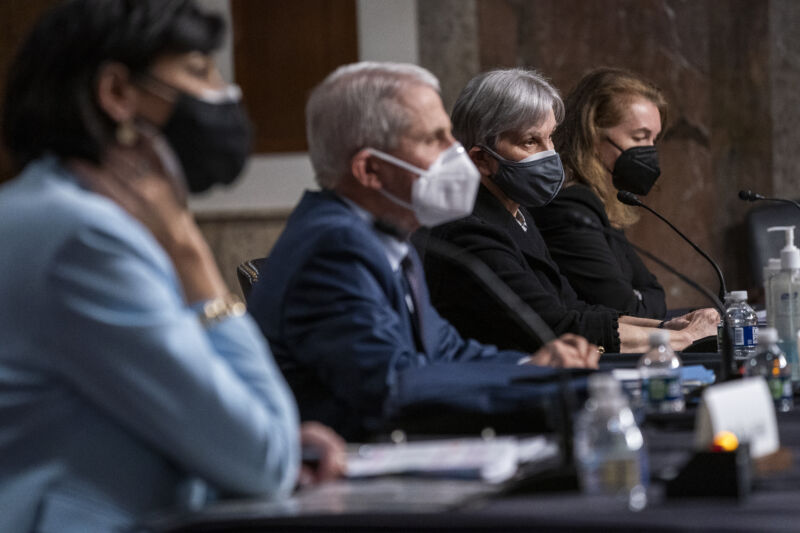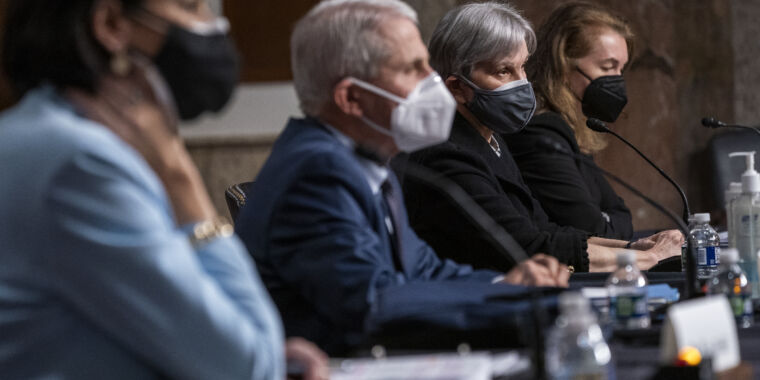
The US Health and Human Service Department has botched multiple aspects of its COVID-19 pandemic response, and those failures can be linked back to longstanding leadership and preparedness deficiencies the department has failed to address for more than a decade, according to a new report by the Government Accountability Office.
“These deficiencies have hindered the nation’s response to the current COVID-19 pandemic and a variety of past threats, including other infectious diseases—such as the H1N1 influenza pandemic, Zika, and Ebola—and extreme weather events, such as hurricanes,” the GAO concluded.
The new report, released Thursday, is the GAO’s ninth assessment of the federal response to the COVID-19 pandemic, and it lays out a series of deficiencies it found at the HHS. But the GAO also emphasizes that it has been here before with the HHS, which encompasses the Centers for Disease Control and Prevention, the Food and Drug Administration, the National Institutes of Health, and the Office of the Assistant Secretary for Preparedness and Response (ASPR), among other components. Since 2007, GAO has given the HHS 115 recommendations for how it can improve its leadership and coordination of public health emergency responses—and the HHS has yet to address 72 of them.
Some of those recommendations directly relate to critical ongoing problems in the federal pandemic response. For instance, in September of 2020, the GAO recommended that the HHS team up with the Federal Emergency Management Agency (FEMA) to develop plans for how to handle supply chain shortages. HHS didn’t address the recommendation, and now in January of 2022, the federal government is still dealing with shortages of supplies. Likewise, in January of 2021, GAO recommended that HHS develop a comprehensive and publicly available strategy for COVID-19 testing, but HHS never did. Now, a year later, Americans have had to scramble to find tests amid a towering wave of cases from the ultratransmissible omicron variant.
Though some government efforts can languish and struggle from a lack of funding, GAO notes that HHS has received $484 billion in COVID-19 relief appropriations from six COVID-19 relief laws. And, so far, the department has only spent $226 billion (47 percent) of the funds and made plans for only $387 billion (80 percent). One of the GAO’s previous recommendations was that the HHS should come up with estimated timelines for spending the rest of its COVID funds. But the HHS didn’t come up with those estimates, arguing that the department needed to remain flexible for incoming requests. In its report Thursday, the GAO pushed back, writing that the estimates “are not binding” and that therefore it would not prevent the HHS from being flexible.
Looming threats
With the unaddressed recommendations and “persistent deficiencies,” GAO put HHS on its “high risk” list. The list identifies federal programs and operations that are vulnerable to waste, fraud, abuse, or mismanagement or need transformation. There are more than three dozen agencies and programs currently on the list.
The addition of the HHS will “help ensure the executive branch and Congress pay sustained attention in order to make additional progress in implementing GAO’s open recommendations and strengthen HHS’s leadership and coordination role for future public health emergencies,” the GAO wrote in its report.
In short, the GAO report outlined five broad areas that the HHS needs to work on. The first is that the department needs to do much better at coordinating its efforts—namely by establishing clear roles and responsibilities for federal leaders as well as key state, local, tribal, territorial, and nongovernmental partners. It also needs to improve how it collects and analyzes data to inform decision-making. The GAO cited a series of problems with inaccurate, incomplete, and inconsistent data that the CDC and HHS collected from states and territories on COVID-19 testing, cases, hospitalizations, nursing homes, and demographics.
Clear and consistent communication with partners and the public was another key problem. The GAO cited instances of poor communication with state and local health departments during the pandemic and previous health emergencies. The CDC, meanwhile, has had several public missteps in communicating health measures to the public, most recently with testing and mask guidance. The GAO also said the HHS needs to strengthen transparency and accountability measures to build public trust. Last, the GAO advised the HHS to have a better grasp of what state and local governments, as well as other partners, are capable of taking on during health emergency responses.
“As devastating as the COVID-19 pandemic has been, more frequent extreme weather events, new viruses, and bad actors who threaten to cause intentional harm loom, making the deficiencies we have identified particularly concerning,” the GAO concluded. Addressing these problems will be difficult, particularly as the pandemic drags on, the report went on. “However, waiting to address the deficiencies we have identified in HHS’s leadership and coordination of public health emergencies is not an option as it is not possible to know precisely when the next threat will occur; only that it will come.”








